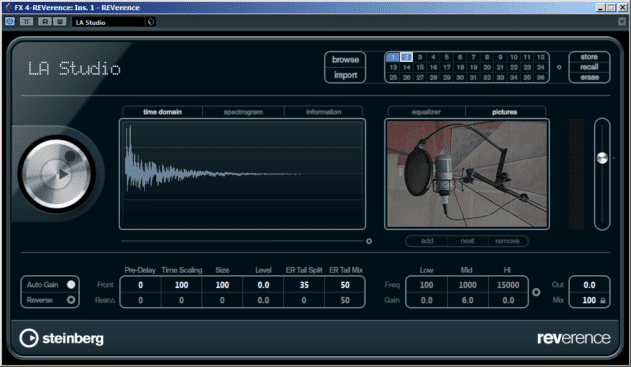The New Realism
The next big thing in the reverb world came in the late 90s in the shape of Sony’s glamorously-named DRE S777 – the first commercial, real-time convolutional reverberator. Unlike algorithmic reverb processors which build their reverbs from the ground up, convolution reverbs capture the sound of real spaces using sophisticated signal measurement and post-processing techniques. The technology has since been distilled into many plugins, including Audio Ease’s Altiverb, Logic’s Space Designer and Cubase’s REVerence. This has also spawned a market for impulse responses (IRs) captured in interesting sonic spaces, and even those taken from classic hardware units.
Audio Player Audio Player Audio Player Audio PlayerThe great advantage of IR-based reverbs is their accuracy when simulating real acoustic environments. However, they offer far less editing flexibility in comparison to their algorithmic cousins, and generally replicate the sound heard in a single listening position coming from a specific source – although multiple captures are possible.
A combination of flavours
When we add reverb to a mix, we can of course take advantage of as many different flavours of sound as we want. Some reverb styles will naturally lend themselves more to particular sounds, certain frequency ranges and specific placement in the mix. By combining a variety of different effects we can create a mix which suits each track.
Take, for instance, a drum sub-mix. Each element can be treated separately, avoiding placing too much reverb on the lower and higher frequencies, concentrating instead on the mid range with plate and small room reverbs, then applying longer hall reverb effects and denser or longer settings only where appropriate.
Audio Player Audio PlayerIt is also worth adding that it’s quite possible to mix a track without artificial reverb added. A stereo delay, for instance, can be used to simulate the echo of a natural environment:
Audio Player Audio Player Audio PlayerThis has the added advantage that the reverb tail does not muddy the mix. In fact the combination of subtle delay combined with reverb works very well on vocals.
Unrealistic reverbs
The final word on this lightning sweep through the world of reverb has to go to the ways in which it can be made to sound unrealistic. Just because a reverb effect doesn’t sound like any real-world acoustic space doesn’t mean it can’t be used in a mix. Some of the most interesting sounds come from heavily modulated and processed reverb settings:
Audio Player Audio Player Audio Player Audio Player Audio Player
